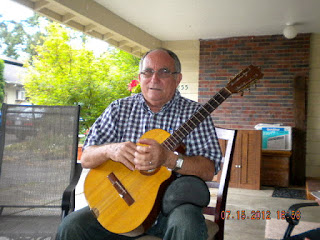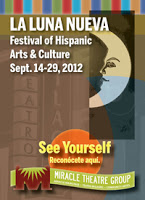La Luna Nueva — Miracle Theatre Group’s festival of Hispanic arts and culture from around the world in celebration of Hispanic Heritage Month — opens in just a couple of weeks, and we couldn’t be more excited about the diverse line-up (see the whole schedule in English; vea el horario completo en español). Our Marketing Assistant Stefanus Gunawan continues his look backstage visits with our guest artists, offering an inside look at their life, their passion, their art. Here, guest blogger Stefanus Gunawan chats with Cuban maestro Efrain Amador.
 In his Luna Nueva festival show, Cuban maestro Dr. Efrain Amador Piñero (founder of the Escuela Cubana del Tres y el Laud) shares the music – and stories – of the Cuban lute and el tres cubano (an instrument that is a fusion of guitar, bandola and tiple). With an impressive dexterity that comes from 20 years of experience and education, the maestro will present a variety of pieces from the Renaissance to modern day, including some of his original compositions that explore the roots of Cuban and Latin American folklore, such as “son” and “punto cubano”. Presented in Spanish with English interpretation at Milagro on Sept. 21 at 8pm. Disfrute, escuche, y relájese al Maestro.
In his Luna Nueva festival show, Cuban maestro Dr. Efrain Amador Piñero (founder of the Escuela Cubana del Tres y el Laud) shares the music – and stories – of the Cuban lute and el tres cubano (an instrument that is a fusion of guitar, bandola and tiple). With an impressive dexterity that comes from 20 years of experience and education, the maestro will present a variety of pieces from the Renaissance to modern day, including some of his original compositions that explore the roots of Cuban and Latin American folklore, such as “son” and “punto cubano”. Presented in Spanish with English interpretation at Milagro on Sept. 21 at 8pm. Disfrute, escuche, y relájese al Maestro.
[Para español, vea abajo.]
This is your first time to visit and play en Portland, correct? What do you think Portlanders will react upon hearing your music?
I have 42 years of playing professionally as a musician around the globe such as Europe, Africa, Middle East, Latin America, but this will be my first tour in Portland and in the U.S. My mission is to elevate, el tres cubano and lute, as concert instruments which traditionally has been utilized in popular music from my country.
After years of investigation, I made a doctoral thesis called “Universality of the Lute and Three Cuban.” Since 1989, Doris Oropesa, who has a Masters in Art, and I have been the founders of the “Cuban School of the Lute and Three Cuban.” With the guitar and the piano, two beautiful instruments, we gave a world tour of el tres cubano and the lute together with the piano as a chamber orchestra presenting well-known works and original scores with my daughter, Ariane Amado, playing the piano; we have encountered an overwhelming acceptance for our artistic work.
I have heard that you are from San Joaquín in the province of Camagüey. How has that influenced your music?
Growing up, I heard el tres cubano with the guitar being played by Cuban country bands producing danceable music, and since then I began to adore both instruments. However, it wasn’t until 1959 that I started to play it, empirically, in our neighborhood festivals where I used to live. Of course those were the years where human beings saw its first light and received its first emotions, when the music penetrated my spirit, and it never left me, even though I didn’t start studying guitar, formally, in the Amadeo Roldan conservatory in Habana until I was 16 years old.
The influence of San Joaquín was definitely to familiarize and acquaint the native rhythms of our folkloric music, which, the majority of my time, it would be utilized in my works as ethnic music that in its essence responds to the Cuban cultural identity while the aesthetic points and the universal techniques are gathered.
How do you incorporate, integrate, and connect your feelings (past, present, and future), heart, and mindset to the music?
Each human being is a spiritual and elemental unity for which the most spiritual focus is always life experiences in this world with all the implications that it brings.
We are the way how we have lived and of the way of our intelligence and sensitivity will have been placed to assimilate that battle with reality. Our musical memory, for example, will retain whatever we have listened to by all of its parameters, forms, and components. We listen to melodies by its harmonies, rhythms, dynamics, movements, or acceptance, but it would solely be musical purity, richness of sound. However, our moods and sensitivity to music, in which each person has a different development grade, the person can capture the style, the age that which it reflects (the Renaissance, Baroque, Classical, Romanticism, national music, or contemporary music, etc.)
The performer’s or composer’s poetic, musical ability permits them to recreate, transform, and project their inner feelings and thoughts when the passage of years has enriched them so much that it will develop their own framework, their own style. Therefore, returning to your question, I think that this is to bring as a conclusion that, thanks to the capacity of the brain of integrating elements, interconnecting all the day’s events and its intimate relation with our spirituality that makes us, more or less, sensitive when we make music, we covert all experiences in esthetic events, and we create by which life has left in us.
What has been the significance in the Cuban culture since the formation and start of Plectro Habana?
The creation of the festival Plectro Habana was a necessity: The young graduates of the school, graduates of el tres cubano or the lute of intermediate or advanced level, observes as their guitar comrades have a competition and a national to international festival where they go demonstrating their abilities and projecting their yearning desire to become an artist.
In 2003 I had the idea, supported as ever by my family and my student-teachers in training, of creating an event that would serve as a platform from which to launch our students’ encouraging results to the public and to cultural agencies; that is, the validity of our project, which was to extract the Plectro instruments such as the lute and el tres cubano from the stereotypes to which they were subjected: to be seen only as instruments accompanying singing and dancing of popular music.
However, I must say that from the birth of the School of Lute and el Tres Cubano and the creation of this festival, the development of the Plectro in Cuba has had an outstanding resurgent which has influenced the quality of musical and technical execution of popular and mainstream music and in the quality of the construction of the instruments (Luthiería) which in order to satisfy the requirements of the music that which in them has become, must have had improved the construction parameters and the vision which before considered itself the importance and projection of these instruments, and the valuable contribution that they have given to the Cuban music upon converting itself from just mere accompaniment to concert instruments, chamber music, Plectro orchestra, and solos before a symphonic orchestra or inside popular ensemble where now they continue their life but with a novel conception and refinement that permits them not only to make harmonies but rather to sing with their own voice in instrumental works and with better quality in their habitual improvisation.
In your opinion, what is the future for el tres cubano and lute? What do you foresee to happen with these instruments?
The future of el tres cubano and the lute, instruments of Plectro definitely cemented their names in 1996 by my wife, Doris Oropesa, when, in a news conference at the Plectro instrument at Logroño in La Rioja, Spain, said, “The 21st century will come with a púa in the hand.” (Note: Púa = Plectro)
She added that each instrument has had its moment in music history: the violin and its family were the preferred instruments during the Baroque and Classical era, 17th and 18th century, respectively; the piano was the king of the courts and aristocratic Europe in the 19th century; the guitar, nominated for its excellence of mobility, was the queen of the 20th century with the arrival of Andrés Segovia at the concert halls to solos and with symphonic orchestra; but all seemed to indicate from 1996 the esthetic tendencies in the composition and the way “to say” and “to sing” was reserved for the portable instruments of higher status forms of folkloric in the grand number of countries, the only instrumental family that hasn’t had an opportunity in music history, until now: Instruments of Plectro. That is my criteria for the future of el tres cubano and the lute in Cuba and of its family in the world, its historic moment has arrived, and they are going to continue projecting itself, each time higher, until the end of time.
This year’s La Luna Nueva festival is made possible with the support of PGE Foundation, The Oregonian, Oregon Arts Commission, Regional Arts & Culture Council and Work for Art. Festival events occur September 14-29, 2012 at El Centro Milagro, 525 SE Stark Street, Portland, Oregon 97214; a complete schedule is available here. Admission varies; several events are FREE. Purchase tickets at 503-236-7253 or www.milagro.org (follow links for “La Luna Nueva” in right-hand sidebar).
***
Este es tu primera vez para visitar a y tocar en Portland? ¿Qué piensa que la gente de Portland reaccionará al oír a la música suya?
Ya he cumplido 42 anos de vida profesional como concertista alrededor del mundo por países de Europa, África, Medio Oriente y América Latina, pero es mi primera gira por los Estados Unidos y, por supuesto en Portland.
La misión de mi arte es elevar al nivel de instrumentos de Concierto al Tres cubano y al laúd que, tradicionalmente, solo se han utilizado en la música popular de mi país. Luego de años de investigación, hice un doctorado cuya tesis se llamo: “Universalidad del Laúd y el Tres Cubano.”
Desde 1989, fuimos Doris Oropesa, la cual tiene Master en Arte, y yo; somos los fundadores de la “Escuela Cubana del Laúd y el Tres Cubano.” Con la guitarra y el piano, los que son dos bellos instrumentos, hemos hecho giras por el mundo dando a conocer al Tres Cubano y al Laúd junto al piano en la música de cámaras con obras del repertorio universal y nuestras, tanto de mi hija, Ariane Amador, como mis propias y en todas partes, hemos encontrado muy buena aceptación a nuestro trabajo artístico.
He escuchado que usted es de San Joaquín de la provincia de Camagüey. Debido a que es de San Joaquín ¿cómo influyó sobre tu música?
En San Joaquín escuché, durante mi infancia, tocar el Tres Cubano junto a la guitarra en la música bailable de un conjunto campesino y desde entonces comencé amar ambos instrumentos. Pero no fue hasta 1959 que comencé tocarlo, empíricamente, en las fiestas del campo donde vivía. Por supuesto que fueron esos años donde el ser humano veía las primeras luces y recibío las primeras emociones, cuando la música penetró todo mi espíritu y ya jamás la abandoné, aunque no comencé mis estudios musicales de guitarra en el conservatorio “Amadeo Roldan” de la Habana, hasta cumplidos los 16 años.
La influencia de San Joaquín fue definitiva para similar y conocer los ritmos mas autóctonos de nuestro folclore el cual, en la mayoría de edad, utilizaría como raíz musical en mis obras que en sus esencias responden a la identidad cultural cubana a la vez que recogen las fuentes estéticas y las técnicas de lo universal.
¿Cómo se integra, conecta, e incorpora tu sentimiento (pasado, presente, futuro), corazón, mente a tu música?
Cada ser humano es una unidad espiritual y material por lo que las fuentes de lo espiritual son siempre sus vivencias en este mundo con todas las implicaciones que esto trae.
Somos lo que hemos vivido y de la manera que nuestra inteligencia y sensibilidad hayan podido asimilar ese choque con la realidad. La memoria musical por ejemplo, guarda todo lo escuchado con todos sus parámetros y formantes o componentes. Escuchamos las melodías con sus armonías, sus ritmos, su dinámica, su movimiento o acogida pero esto sería solamente lo puramente musical, lo sonoro. Sin embargo, nuestra sensibilidad a la música, que en cada ser humano tiene diferente grado de desarrollo, puede captar el estilo, la época que refleja (renacimiento, barroco, clasicismo, romanticismo, música nacionalista o la época contemporánea, etc.)
La capacidad poética de un interprete o de un compositor le permiten recrear, transformar y proyectar su mundo interior cuando al paso de los años se ha enriquecido tanto que pueda desarrollar su propia forma de hacer, su estilo propio. Entonces, retomando tu pregunta, creo que lo dicho puede traer como conclusión que, gracias a la capacidad del cerebro de integrar elementos, interconectar todo lo vivido y su relación intima con nuestra espiritualidad que nos hace mas o menos sensible, cuando hacemos música, convertimos todas las vivencias en un hecho estético, creamos por lo que la vida ha dejado en nosotros.
¿Qué ha significado en la cultura de Cuba desde que la formación de Plectro Habana empezó?
La creación del festival Plectro Habana fue una necesidad: Los jóvenes egresados de las escuelas, graduados de Tres Cubano o Laúd de nivel medio o superior, observaban como sus compañeros de guitarra tenían un concurso y festival al nacional e internacional donde ir mostrando sus habilidades y proyectando sus deseos y anhelos como artistas.
En el 2003 tuve la idea, siempre con el apoyo de mi familia y de los jóvenes profesores que iba formando, de crear un evento que sirviese de plata forma desde donde lanzar ante el público los resultados tan alentadores que obteníamos con nuestros discípulos y dar a conocer ante los organismos de la cultura, la validez de nuestro proyecto, es decir, sacar a estos instrumentos de Plectro como el Laúd y el Tres Cubano del encasillamiento a que estaban sometidos: de verlos solamente como instrumentos acompañantes del canto y del baile en la música popular.
Pero hay que decir a partir de la fundación de la “Escuela Cubana del Laúd y el Tres Cubano” y la creación de este festival, el desarrollo del Plectro en Cuba ha tenido un resurgimiento asombroso que ha influido en la calidad de la ejecución musical y técnica de los músicos cultos y populares, en la calidad de la construcción de los instrumentos (Luthiería) que para satisfacer las exigencias de la música que en ellos se hace, han tenido que mejorar todos los parámetros de construcción y la visión que antes se tenia de la importancia y proyección de estos instrumentos y el valioso aporte que han dado a la música Cubana al convertirse de meros acompañantes, en instrumentos concertantes, dentro de la música de cámara, en orquestas de Plectro, como solistas ante una orquesta sinfónica o dentro de los conjuntos populares donde ahora continúan su vida pero con una concepción novedosa y refinada que les permite no solo hacer armonías, sino cantar con voz propia en obras instrumentales y con mejor calidad en sus improvisaciones habituales.
Para usted ¿Cuál es el futuro del Tres Cubano y Laúd? ¿Qué pasará?
El futuro del Tres Cubano y el Laúd, instrumentos de Plectro quedó definido en 1996 por mi esposa la master Doris Oropesa cuando en una conferencia de prensa en el festival de instrumentos de Plectro de Logroño en La Rioja, España, dijo: “El siglo XXI vendrá con una púa en la mano” (Nota: Púa o Plectro)
Ella añadió que cada instrumento ha tenido su momento en la historia de la música: el violín y su familia fueron los instrumentos preferidos durante el Barroco y el Clasicismo, siglos XVII y XVIII; el piano fue el rey en los salones de las cortes y de la aristocracia Europea en el siglo XIX; la guitarra, nómada por excelencia fácil de transportar, fue la reina del siglo XX con la llegada de Andrés Segovia a las salas de conciertos a solo y con orquestras sinfónicas; pero todo parecía indicar desde aquel 1996 que las tendencias estéticas en la composición y el turno de “decir” y “cantar” estaba reservado para los instrumentos portadores de las mas raigales formas del folclore en gran numero de países, la única familia instrumental que no había tenido una oportunidad en la historia de la música hasta entonces: Los instrumentos de Plectro. Ese es mi criterio para el futuro del Tres Cubano y el Laúd en Cuba y de su familia en el mundo, ha llegado su momento histórico y van a continuar proyectándose cada vez mas alto hasta el final de los tiempos.

